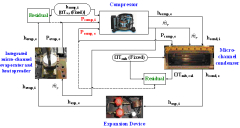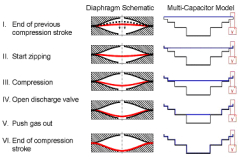CTRC Breakthroughs
Small Scale Refrigeration
Research Topics
Microscale Transport and Microchannels
Electrically Actuated Microscale Flows
Thin-Film Transport, Wicks and Heat Pipes
Novel Air and Impingement Cooling Approaches
Surface and Interface Engineering
Thermal Materials R&D
Thermal Interfaces
Small-Scale Refrigeration
Exploratory and Novel Concepts
Renewable and Sustainable Energy
 When choosing the coolant for a specific application, the material
compatibility, toxicity, corrosion properties have to be considered
in addition to their thermal performance. This project focused
on answering these system considerations. As a part of the project,
an extensive liquid-loop coolant database was developed with 56
single-phase and two-phase fluids that can be used in electronics
cooling. In addition, a simulation tool was developed to
predict the coolant performance in single-phase and two-phase flow
microchannels.
When choosing the coolant for a specific application, the material
compatibility, toxicity, corrosion properties have to be considered
in addition to their thermal performance. This project focused
on answering these system considerations. As a part of the project,
an extensive liquid-loop coolant database was developed with 56
single-phase and two-phase fluids that can be used in electronics
cooling. In addition, a simulation tool was developed to
predict the coolant performance in single-phase and two-phase flow
microchannels.
Miniature Scale Linear Compressor for Electronics Cooling
 A linear compressor is considered a promising new development in
component technology due to the potential for high performance and
high scalability. This work has developed a comprehensive model of a
linear compressor based on first principals. This model has shown
good agreement when compared with experimental data and can be used
for future development of linear compressor technology. The figure
is a schematic of a linear compressor.
A linear compressor is considered a promising new development in
component technology due to the potential for high performance and
high scalability. This work has developed a comprehensive model of a
linear compressor based on first principals. This model has shown
good agreement when compared with experimental data and can be used
for future development of linear compressor technology. The figure
is a schematic of a linear compressor.
Miniature-Scale Refrigeration System (MSRS) for Electronics Cooling
 The
simulation model for the refrigeration system is based on
thermodynamics, heat transfer and fluid mechanics concepts applied
to miniature scale components of a micro vapor compression system,
including the compressor, mini-channel condenser, expansion device,
and integrated cold plate evaporator and heat spreader. The system
model shown in the figure simulates a refrigeration system with an
active expansion device. Hence, only two parameters, suction and
discharge pressures, need to be estimated to completely define the
operating conditions and performance of the vapor compression
system. The model predicts all state points of the
micro-refrigeration system and the power consumption and the
efficiency of the cooling system.
The
simulation model for the refrigeration system is based on
thermodynamics, heat transfer and fluid mechanics concepts applied
to miniature scale components of a micro vapor compression system,
including the compressor, mini-channel condenser, expansion device,
and integrated cold plate evaporator and heat spreader. The system
model shown in the figure simulates a refrigeration system with an
active expansion device. Hence, only two parameters, suction and
discharge pressures, need to be estimated to completely define the
operating conditions and performance of the vapor compression
system. The model predicts all state points of the
micro-refrigeration system and the power consumption and the
efficiency of the cooling system.
Miniature-Scale Daiphragm Compressor for Electronics Cooling
 Results
from the compressor model indicate that an Miniature Scale Diaphragm
Compressor (MSDC) has excellent thermodynamic performance and good
potential for miniaturization and integration with
micro-refrigeration systems to cool high-heat-dissipation
microprocessors. The diaphragm compressor consists mainly of two
contoured conductive planes that serve as electrodes. These are
separated by dielectric insulation layers and a gas/refrigerant gap.
If a voltage differential is applied between the electrodes, the
electrostatic force deforms the diaphragm and pulls it towards the
electrode on the chamber wall. Suction and discharge flapper
mini-valves control the refrigerant flow in and out of the
compressor chamber. Target parameters for the diaphragm compressor
include a heat removal of 200 W, pressure head of 750 kPa, pressure
ratio of 2, and flow rate of 3000 ml/min, accomplished with a
diaphragm compressor of 80 mm in diameter and 20 mm in height.
Results
from the compressor model indicate that an Miniature Scale Diaphragm
Compressor (MSDC) has excellent thermodynamic performance and good
potential for miniaturization and integration with
micro-refrigeration systems to cool high-heat-dissipation
microprocessors. The diaphragm compressor consists mainly of two
contoured conductive planes that serve as electrodes. These are
separated by dielectric insulation layers and a gas/refrigerant gap.
If a voltage differential is applied between the electrodes, the
electrostatic force deforms the diaphragm and pulls it towards the
electrode on the chamber wall. Suction and discharge flapper
mini-valves control the refrigerant flow in and out of the
compressor chamber. Target parameters for the diaphragm compressor
include a heat removal of 200 W, pressure head of 750 kPa, pressure
ratio of 2, and flow rate of 3000 ml/min, accomplished with a
diaphragm compressor of 80 mm in diameter and 20 mm in height.



